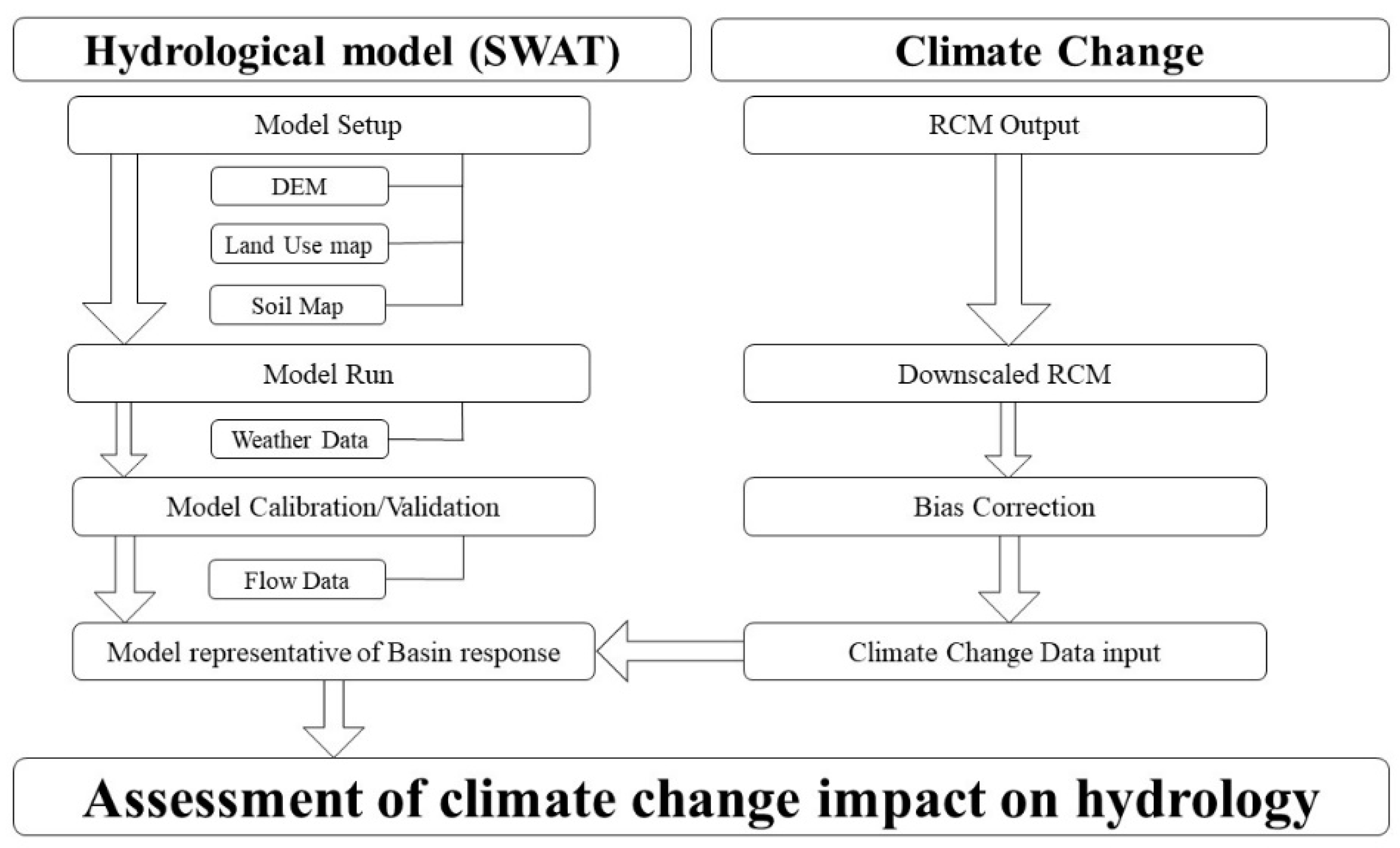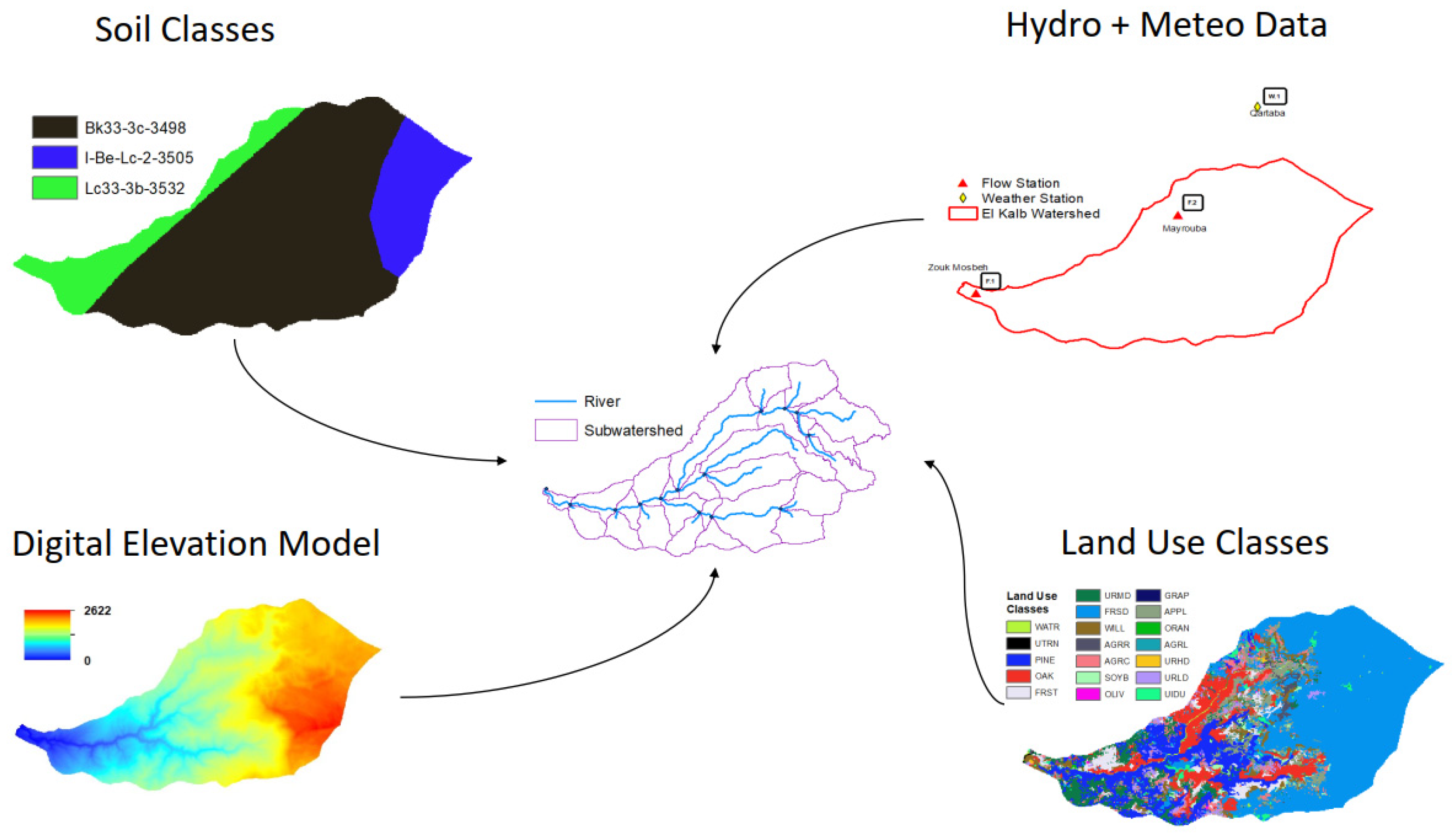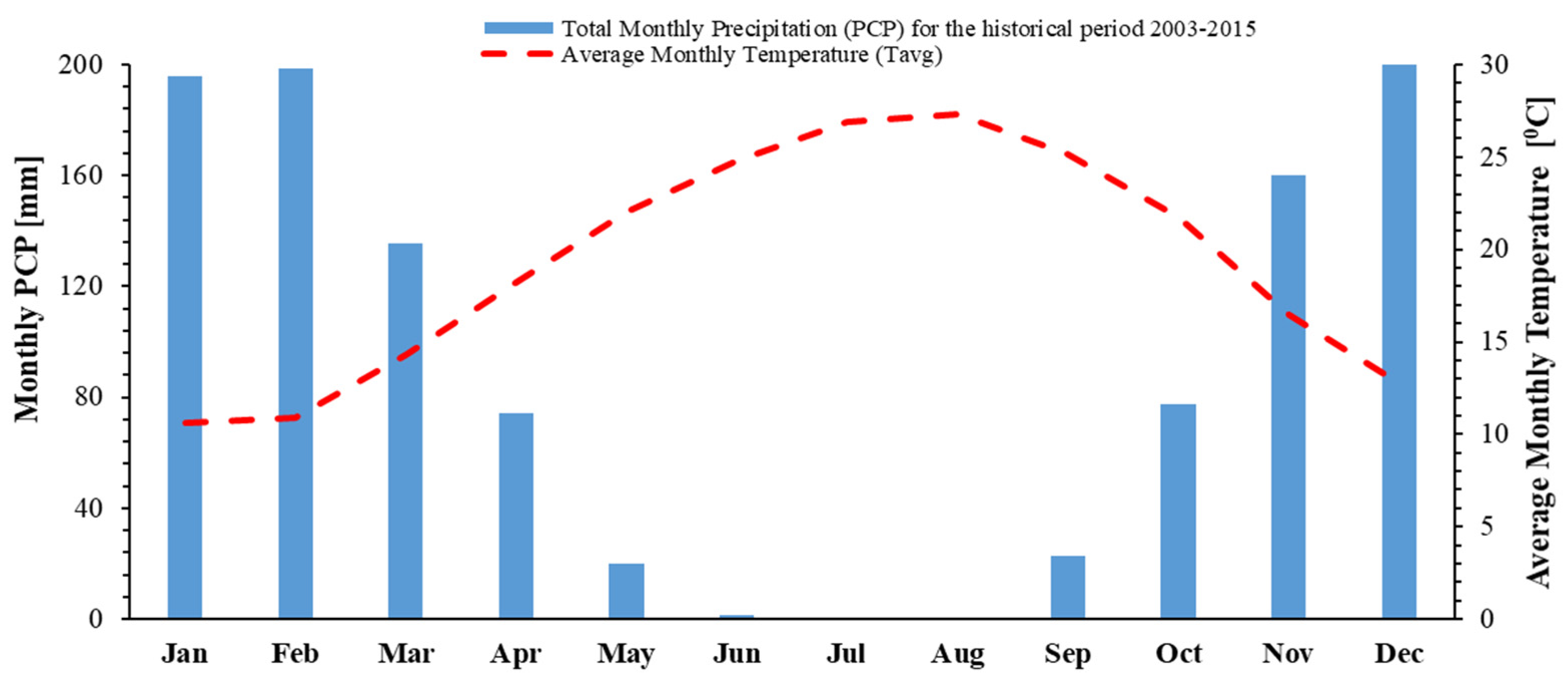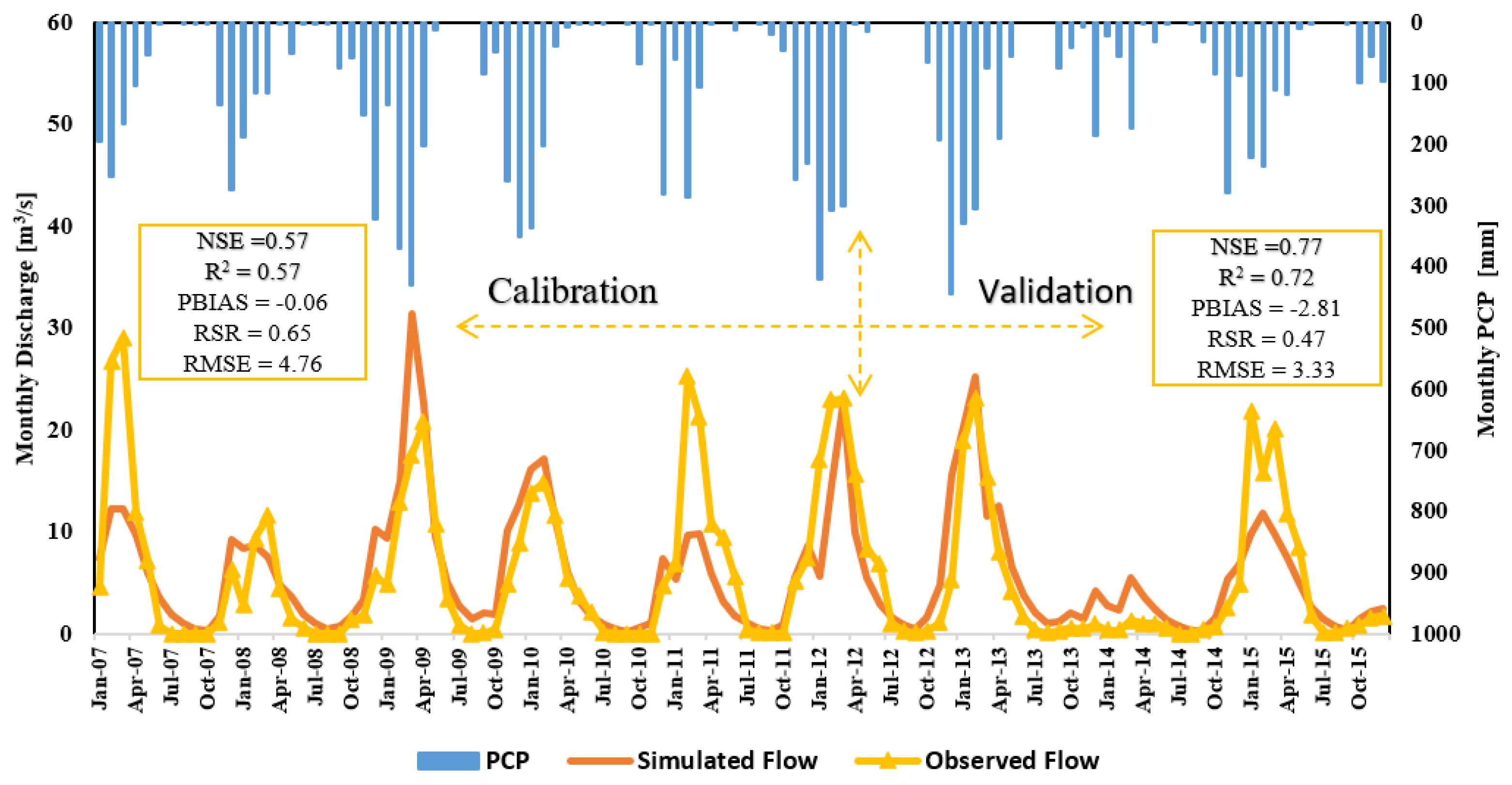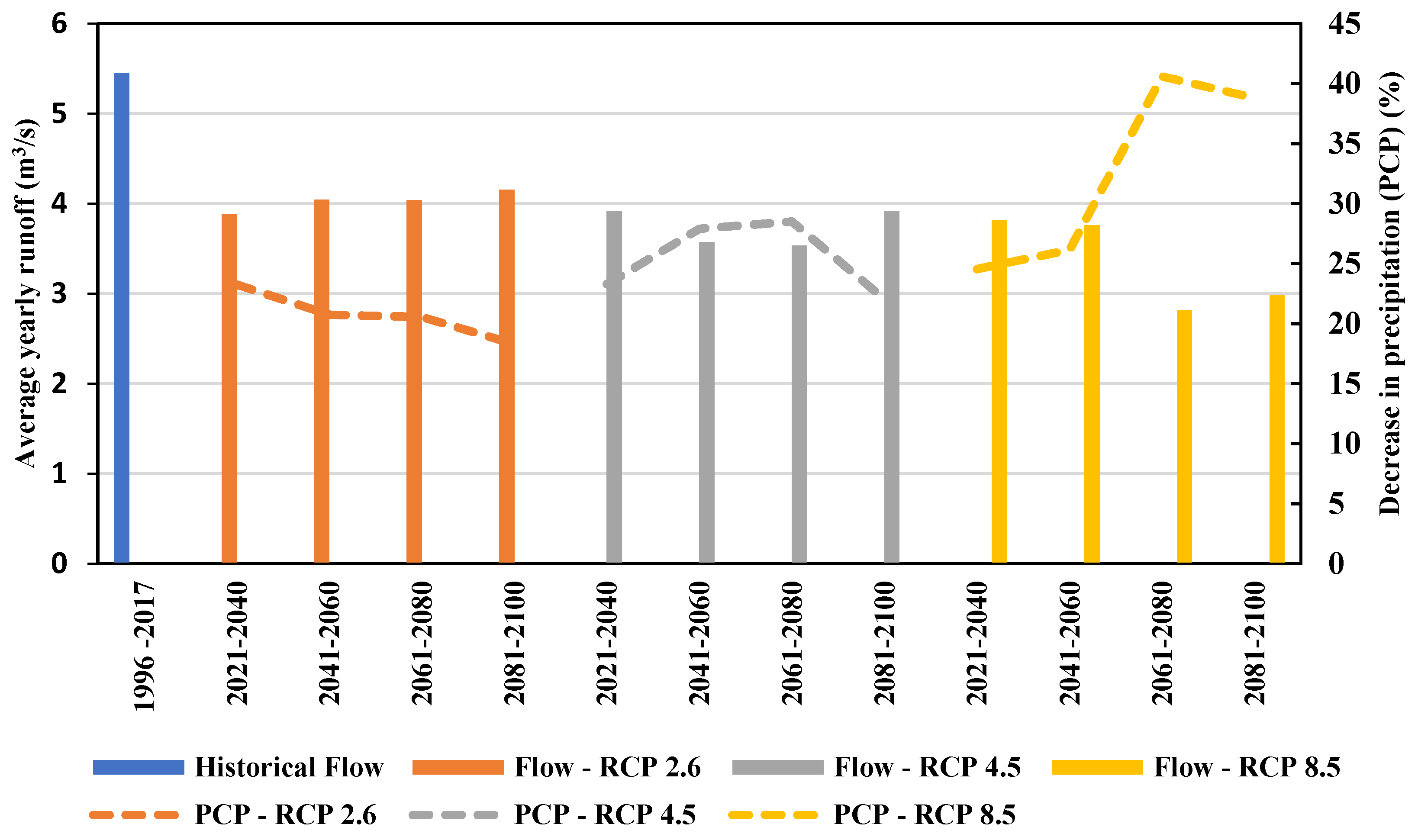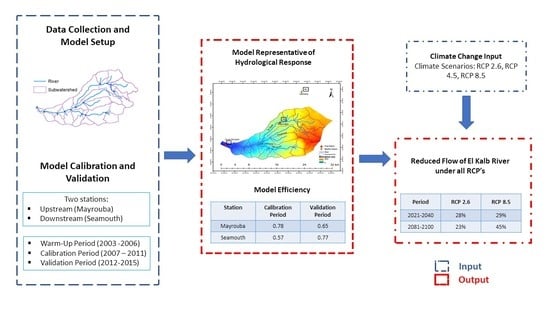1. Introduction
Long-term records showing the impacts of climate change continue to prove the dire need for sustainable management and planning of water resources. The variation in precipitation due to climate change has had significant repercussions on the supply of water resources [
1]. According to the 5th assessment report (AR5) of the Intergovernmental Panel on Climate Change (IPCC), the three-decade period lasting from 1983 to 2012 was likely the warmest 30-year period of the last 1400 years in the northern hemisphere. A linearly rising trend of global warming in the range of 0.65 °C to 1.06 °C over the 1880–2012 period was reported [
2]. The United Nation’s 2030 Agenda stipulated one of the indicators for Sustainable Development Goal no. 13 (SDG 13: Climate Action) to specifically assess the number of countries with national adaptation strategies that help consider climate risks when making decisions. This is in coordination with SDG 6 that seeks the sustainable management of water and sanitation systems [
3]. Indeed, climate change was found to be the most influential planetary boundary affecting freshwater use [
4].
Conceptual and physically based models to assess the impact of climate change on water resources have been used [
5]. The Soil and Water Assessment Tool (SWAT), a physically based model, has been used for streamflow prediction [
6,
7,
8,
9,
10,
11]. SWAT is used to address watershed management questions by predicting the effects of changes in soil, land use, and climate on water quantity and quality [
12]. Recently, Haghighi et al. [
13] used the SWAT model on the Marboreh watershed in Iran to prove that the climate change impact on the hydrology of the watershed is more significant than land-use change. Mittal et al. [
14] used the SWAT model on the Kangsabati river in India to show that the combined impact of dam construction and climate change will significantly reduce river flow, while climate change alone will reduce the high peak flows in the near future (2021–2050). Physically based models are used to help assess current and future problems, which is a prerequisite to planning water management policies and strategies [
15,
16].
Located in the Middle East, Lebanon is considered to have sufficient natural water resources. Yet, its potential annual renewable water resources have decreased from a value of 1155 to 1074 m
3/capita/year, between 2002 and 2008 [
17]. Access to safe drinking water reaches 37% of the Lebanese population, whereas access to sanitation services reaches only 20% of the population [
18]. Most of the water-related challenges in Lebanon have been attributed to poor management and planning and outdated legislations [
19,
20]. The country’s score in the degree of implementation of integrated water resources management is medium to low, implying that implementation is taking place but with limited geographic coverage and stakeholder participation [
21]. The decrease in snowpack melt rate changed from 97 days prior to 2000 to 86 days during the period of 2000–2010, and to 64 days during the period of 2010–2018 [
22]. Furthermore, defining the exact number of rivers in Lebanon has become a source of debate as some rivers remain dry for more than 9 months a year and 60% of springs have disappeared [
22]. Discharge from rivers such as Litani river, Al Kabir river, and El Damour river decreased on average by 40%, while that of Beirut river decreased by 55% [
22]. The flow of 12 perennial rivers in Lebanon decreased by 23% in 40 years, compared to the year 1965 [
23]. Similarly, the flow of 60 seasonal watercourses decreased by 50% below normal levels [
24]. In addition, the Litani river, the largest river in length and width in Lebanon, showed a drying trend in the period between 1900 and 2008, with a reduction rate varying between 0.1 and 0.8 m
3/s per decade [
25]. The cost of reduced agricultural, domestic, and industrial water supply due to climate change was estimated at USD 21 million, USD 320 million, and USD 1200 million by 2020, 2040, and 2080, respectively. Similarly, the reduction in water supply for the generation of hydroelectricity was estimated at USD 3 million, USD 31 million, and USD 110 million by 2020, 2040, and 2080, respectively [
26].
At the level of water demand, a 10% climate-induced increase in total water demand is anticipated in Lebanon by 2050 [
27]. The COVID-19 pandemic is further expected to exacerbate current conditions where water demand is estimated to have increased by 9 to 12 L per person per day for need of better sanitation [
28]. The country is already using more than two-thirds of its available water resources with an anticipated 22% increase in total annual demand by 2035 [
29]. Considering the current deficiency in the national water budget, and the low national water storage capacity (6% compared to 85% MENA average), the country is highly susceptible to water shortage [
30]. The water deficit is expected to reach 610 million cubic meters by 2035 [
31].
According to the third national communication to the United Nations Framework Convention on Climate Change by the Ministry of Environment, viable adaptation measures in the water sector include: establishing reliable data collection and storage systems, improving the feasibility of alternative sources of water, and developing climate-based watershed management plans [
26]. Yet, informed decision-making and planning require reliable projections of water quantities. Despite the reported attempts to forecast the impact of climate change on the water sector in Lebanon, river management requires more extensive research in terms of physically based hydrological modeling; only seven studies have addressed the impact of climate change on water quantity and four have modeled the impact of climate change on streamflow [
15]. This research assessed the impact of climate change on the streamflow of the El Kalb river, a major perennial river in Lebanon. A physically based model, SWAT, and three climatic scenarios (RCP 2.6, RCP 4.5, and RCP 8.5) were used to simulate the watershed hydrology and to forecast the potential short- and long-term flow changes. This research will contribute to the evaluation and planning objectives under future climate conditions, especially for the projected planned treatment plants along the river stretch.
2. Materials and Methods
The studied watershed includes a major historical river in Lebanon, El Kalb River, located in the country’s west central administrative governate, Mount Lebanon (
Figure 1). The watershed has an area of 252 km
2, covering an altitude ranging from 0 m near its estuary (at sea mouth to the east) to 2622 m at the hilltops of Sannine to the west where it originates with an average annual precipitation of 1093 mm. The three main tributaries—Zerghaya, El Salib, and Hardoum—join at their confluence in Deir Chomra to form the El Kalb river that discharges in the Mediterranean Sea with an average river discharge of 5.6 m
3/s [
32].
Figure 2 illustrates the methodology used in this study. Three input datasets, describing the physical features of the basin, were used: Digital Elevation Model (DEM), land-use map, and soil map. The basin’s response was simulated at the level of multiple Hydrologic Response Units (HRUs). Historical climatic data were used to calibrate the model for the years 2003 to 2011, after which the model was validated for 4 years (2012 to 2015). Climate change data, retrieved from a Regional Climate Model (RCM), were downscaled and bias-corrected, and then used to model the impact of projected climatic change on the river flow.
The Soil and Water Assessment Tool (SWAT), a physically based hydrological model, was adopted to simulate flow in the watershed. Developed by the United States Department of Agriculture (USDA), SWAT is a deterministic semi-distributed model that divides the catchment into HRUs based on a unique set of data, including land use/cover, soil type, and slope. SWAT models the land phase of the hydrologic cycle using the water balance equation (Equation (1)) [
33]:
where
SWt is the final soil water content (mm),
SW0 is the initial soil water content on day
i (mm),
t is the time (days),
Rday is the amount of precipitation on day
i (mm),
Qsurf is the amount of surface runoff on day
i (mm),
Ea is the amount of evapotranspiration on day
i (mm),
wseep is the amount of water entering the vadose zone (unsaturated zone; saturated zone) from the 0 soil profile on day
i (mm), and
Qgw is the amount of return flow on day
i (mm).
The model requires a specific set of input data, including topography, land use/land cover, soil, and weather data (
Table 1 and
Table 2,
Figure 3). The basin was divided into 27 subbasins and 123 HRUs. Data were retrieved from the National Council for Scientific Research (CNRS), Food and Agriculture Organization Digital Soil Map of the World (FAO-DSMW), and the Litani River Authority (LRA). DEM, soil, land use, flow, and weather data were used for the model run, model calibration, and validation.
The past flow and weather data (from 2003 till 2015) were used for: model warm-up (2003–2006), calibration (2007–2011), and validation (2012–2015). The data were retrieved from the records of two flow stations (in Zouk Mosbeh city and Mayrouba village) and one weather station (in Qartaba village) (
Table 3). As the weather station inside the watershed had only six years of data, Qartaba weather station, 5 km outside the watershed, was used. Air temperature and precipitation data for both stations were compared using overlapping years that showed similar seasonal patterns. Weather data include daily precipitation (mm), daily maximum and minimum temperature (°C), solar radiation (W/m
2), wind speed (m/s), and relative humidity (%). Monthly precipitation and temperature over the past period are shown in
Figure 4, where the average yearly precipitation is 1093 mm with an average of 82 wet days, and the average temperature is 15.88 °C.
The study area includes 19 land use/land cover classes dominated by deciduous forest (42.58%). Only 9.45% of the land use is urban, of which 63% is residential of medium density (
Figure 5). Most rural land cover is covered by wild trees such as oak and pine, as well as apple and other fruit trees. The soil map was obtained from Digital Soil Map of the World [
34], and three main soil types are found in the watershed (clay, clay loam, and loam), with clay as the dominant soil.
To quantify the impact of climate change on the streamflow of EL Kalb river, projected weather parameters were used for different climate scenarios. Those were adopted from the output of the Coordinated Regional Downscaling Experiment (CORDEX), and obtained from the Lawrence Livermore National Laboratory at the Earth System Grid Federation (ESGF) [
35,
36]. The scenarios considered in this study cover the Representative Concentration Pathways (RCPs) 2.6, 4.5 and 8.5.
The driving model used was MPI–ESM–MR, which is a General Circulation Model (GCM) developed by the Max Planck Institute for Meteorology Climate Service Center. Due to its relatively coarse scale (grid resolution 0.44°), the GCM was dynamically downscaled using the REMO 2009 regional climate model (RCM). Due to the geographical difference (0.147°) between the station in Qartaba and the center of the nearest grid cell, bias correction was needed during the calibration stage. The downloaded simulated climate change data cover future and historical (overlapping observed weather data from Qartaba station) periods. The simulated climate change data for the El Kalb watershed were prepared using the CMhyd (Climate Model data for hydrological modelling) [
37]. Bias correction was performed as the spatial resolution of the General Circulation Models (GCMs) is generally too coarse to be directly used in fine-scale impact studies [
38,
39]. Bias correction was applied on temperature and precipitation using the additive linear scaling and multiplicative linear scaling methods, respectively, on the overlapping historical period [
40]. The future weather data, covering the timespan from 2021 to 2100, were divided into four 20-year periods for future predictions (
Table 4).

